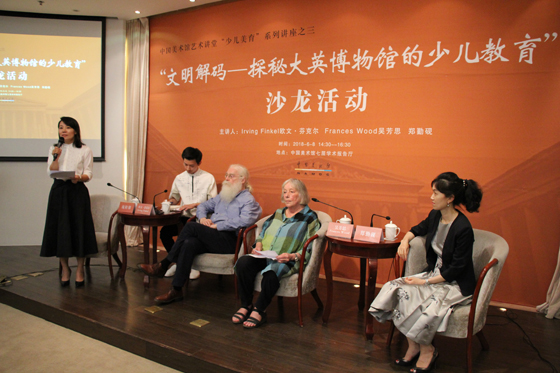"Decoding the Secret of Children’s Education at the British Museum"Salon Event Successfully Held
Source:: Time:2018年06月28日
On June 8, 2018, the third “Decoding the Secret of Children’s Education at the British Museum” salon event of the “Arts Education for Children” series of lectures at the National Art Museum of China (NAMOC) was successfully held. Professor Irving Finkel, a British museum expert, and Ms. Frances Wood, the British sinologist and historian, together with Associate Professor Zheng Qinyan of the School of Art Management and Education of the Central Academy of Fine Arts, were invited to give lectures and exchanges on the topic of children's education at the British Museum. From the perspective of their respective fields of study, the three museum insiders at home and abroad talked about children's education at museum from different perspectives. Combining specific education cases, they sorted out museum education theories and methods and proposed targeted museum education instruction. The salon activities were well-received by the audience.
Professor Irving Finkel, British philologist, cuneiform expert, Assyrian expert, loves education. He wrote the history of his research into storybooks, so that children can have a glimpse of the world’s ancient civilizations and keep in mind the rich and splendid wealth of human history. Ms. Frances Wood, a sinologist and historian in the United Kingdom, served as the Director of the Oriental Collections of the British Library and member of the International Dunhuang Project Steering Committee. She is known as the “Woman in Charge of Chinese History” in the United Kingdom. Dr. Zheng Qinyan is an associate professor and master graduate supervisor of the School of Art Management and Education of the Central Academy of Fine Arts and a visiting scholar at Columbia University. In 2010, she established the Children's Arts Education Studio of the Central Academy of Fine Arts and served as an expert in Expert Library of the National Training Plan of the Ministry of Education.
During the salon, Professor Irving Finkel enlightened the audience on how to conduct museum education. He held that museum staffs must first love the museum. When observing the audience in the museum, we will find that what attract the audience are not exhibits, but the phone or manual. Therefore, museum education should take the initiative to find suitable ways for the audience to learn to listen and observe, so that they can return home with some gaining. For the children’s education in the museum, Professor Finkel held that “dialogue” with children came first. “In the dialogue, you can pass the light of wisdom to the children and develop their imagination. This is magic.” Ms. Frances Wood shared cases themed on “children in British Museum and gallery” so as to discuss the educational role of museums from the perspective of western researcher who had profound knowledge of eastern culture. She held that, “children should frequent museums and art galleries. It contributes to their growth. Children's museum education should mobilize multiple senses to participate in the experience and allow them to experience a wealth of exhibits in various ways.” Dr. Zheng Qinyan shared with audience a speech entitled “Children's Education that Inspires Creativity”. She talked about her own case of leading children to the British Museum and shared with her audience many thoughts on the core concepts of museum education. She summed up, “The exploration of the world has never stopped and the discovery of humans in museums has never stopped. The museum is a place for us to share knowledge, share collection resources, and convey love. It is only on this basis that museums education really makes a difference”.
In the Q&A section, the host invited Professor Finkel to summarize what he understood as the nature of museum education in a concise way. Professor Finkel replied, “The core essence of museum education is to gain knowledge unconsciously during the visit... Museum education can eliminate prejudice, bridge the gap between ancient people and modern people, and help people better learn from history and look forward to the future.” A museum education industry insider asked, what form of museum education can satisfy the needs of children and parents at the same time? Professor Finkel answered that when considering the needs of adults and children, the label design should be personalized and more interesting to attract the attention of the audience. Ms. Frances Wood added, “The purpose of the parent-child activity in the museum is not to educate children but to allow parents to enjoy the visit with their children.” Dr. Zheng Qinyan believed that parenting guides should be based on discovery in museum education. Attractive educational content allows parents and children to explore and learn together.
The sharing of the three museum insiders inspired audience to reflect on the museum education. In the process of exploring the children’s education in the British Museum, many sparks of wisdom collided with each other, so that everyone could come up with more dynamic strategies and approaches about the children’s education of the museum. The audience was full of ideas. They all expressed that this salon activity was lively and relaxed, broadened their international perspective in the field of children's education in museums. In the future they would often bring their children to museums and art galleries to enjoy happy hours. NAMOC has always attached importance to the education of art galleries for young children and has formed a series of children's education brands. In the future, it will continue to innovate public education projects that are rich in the spirit of the times and continue to meet the public's demand for aesthetic education. Your attention and enthusiastic participation are welcomed.


